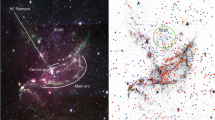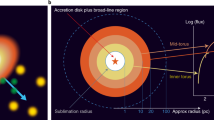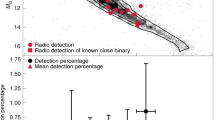Abstract
Natural OH maser emission originates in the dusty circumstellar envelopes of highly evolved long-period variables and super-giant stars undergoing mass-loss. The OH spectra of such stars, at a microwave frequency of 1,612 MHz, are sharp double-peaked emission line profiles in which the two strongest features have a velocity separation of 5–60 km s−1. Their far infrared colours are typical of sources with colour temperatures below 500 K. Most of the 200 known OH/infrared stars were discovered in systematic OH-line surveys, at 1,612 MHz along the galactic plane1–4, generally using small antennae and having a limiting sensitivity of ∼ 1 Jy. But 40 well-studied sources were readily detected with the IRAS satellite5 at 12, 25 and 60 µm and were characterized by a limited range of infrared colours. A more efficient method for detecting new OH/infrared stars is to begin with IRAS source positions, selected for appropriate infrared colours, and using radio-line observations to confirm the OH properties. We demonstrate the validity of this approach here, using the Arecibo 305 m radio-telescope to confirm the 1,612 MHz line observations of sources in IRAS Circulars 8 and 9 (ref. 6); our present observations identify 21 new OH/infrared stars. The new sources have weaker 1,612 MHz fluxes, bluer (60–25) µm colours and a smaller mean separation between the principal emission peaks than previous samples.
This is a preview of subscription content, access via your institution
Access options
Subscribe to this journal
Receive 51 print issues and online access
$199.00 per year
only $3.90 per issue
Buy this article
- Purchase on Springer Link
- Instant access to full article PDF
Prices may be subject to local taxes which are calculated during checkout
Similar content being viewed by others
References
Caswell, J. L. & Haynes, R. F. Mon. Not. R. astr. Soc. 173, 649–669 (1975).
Johansson, L. E. B., Andersson, C., Goss, W. M. & Winnberg, A. Astr. Astrophys. Suppl. 28, 199–210 (1977).
Bowers, P. F. Astr. Astrophys. Suppl. 31, 127–146 (1978).
Baud, B., Habing, H. J., Matthews, H. E. & Winnberg, A. Astr. Astrophys. 95, 156–170 (1981).
Olnon, M. et al. Astrophys. J. 278, L41–44 (1984).
IRAS Circulars 8 & 9 Nature 308, 114 (1984).
Bridle, A. H., Davis, M. M., Fomalont, E. B. & Lequeux, J. Astr. J. 77, 405–443 (1972).
Neugebauer, G. et al. Astrophys. J. 278, L1–L6 (1984).
Elitzur, M., Goldreich, P. & Scoville, N. Astrophys. J. 205, 384–396 (1976).
Author information
Authors and Affiliations
Rights and permissions
About this article
Cite this article
Lewis, B., Eder, J. & Terzian, Y. Detection of OH radicals from IRAS sources. Nature 313, 200–202 (1985). https://doi.org/10.1038/313200a0
Received:
Accepted:
Issue Date:
DOI: https://doi.org/10.1038/313200a0
This article is cited by
-
Efficient detection of water masers
Nature (1988)
Comments
By submitting a comment you agree to abide by our Terms and Community Guidelines. If you find something abusive or that does not comply with our terms or guidelines please flag it as inappropriate.



